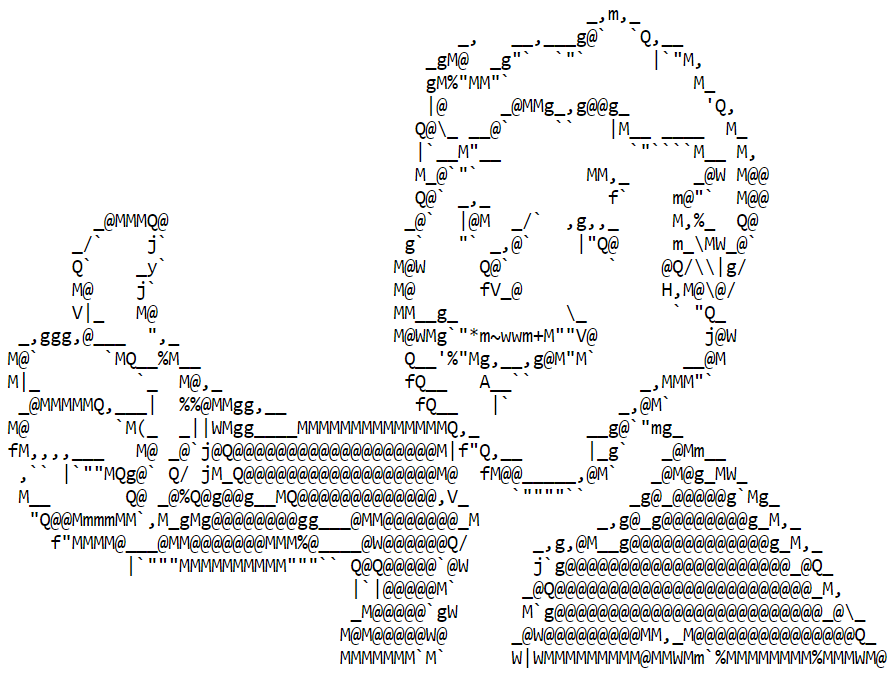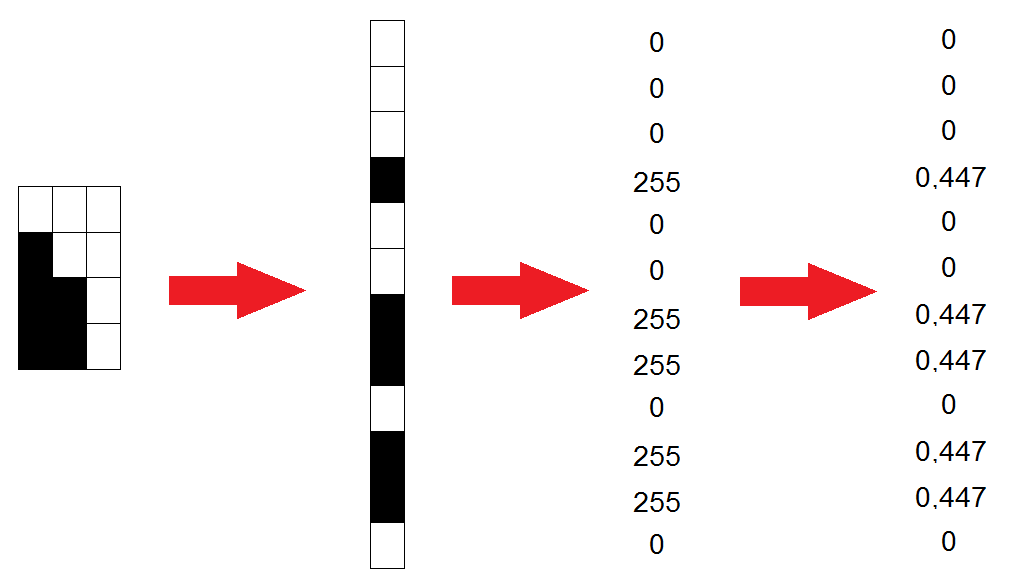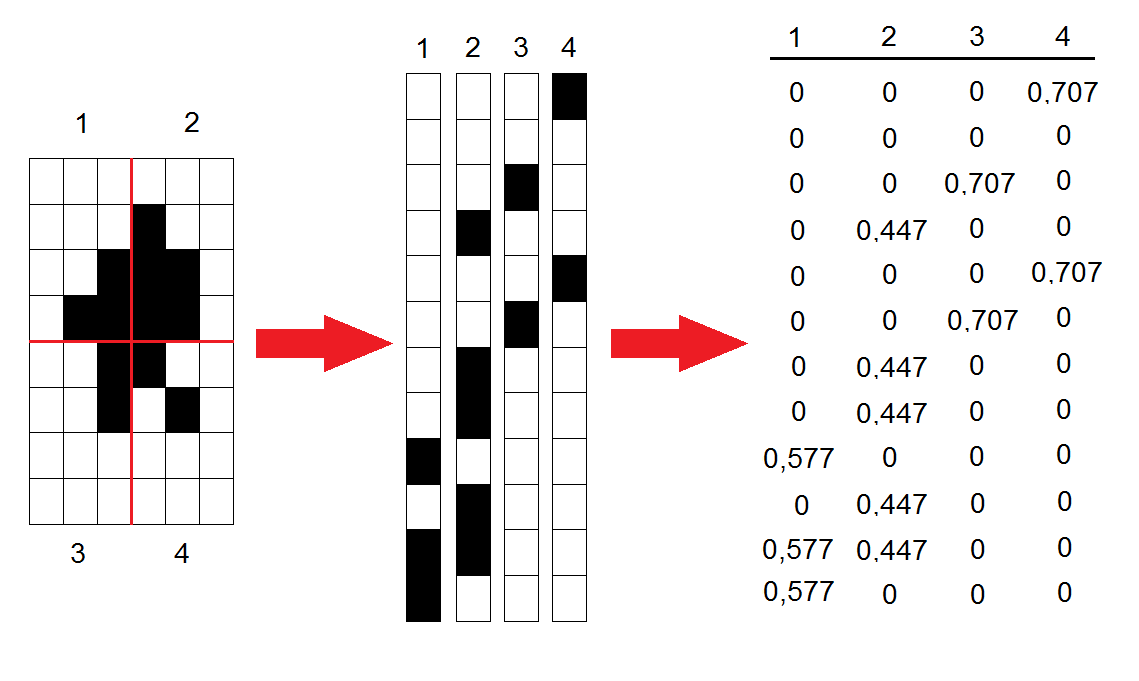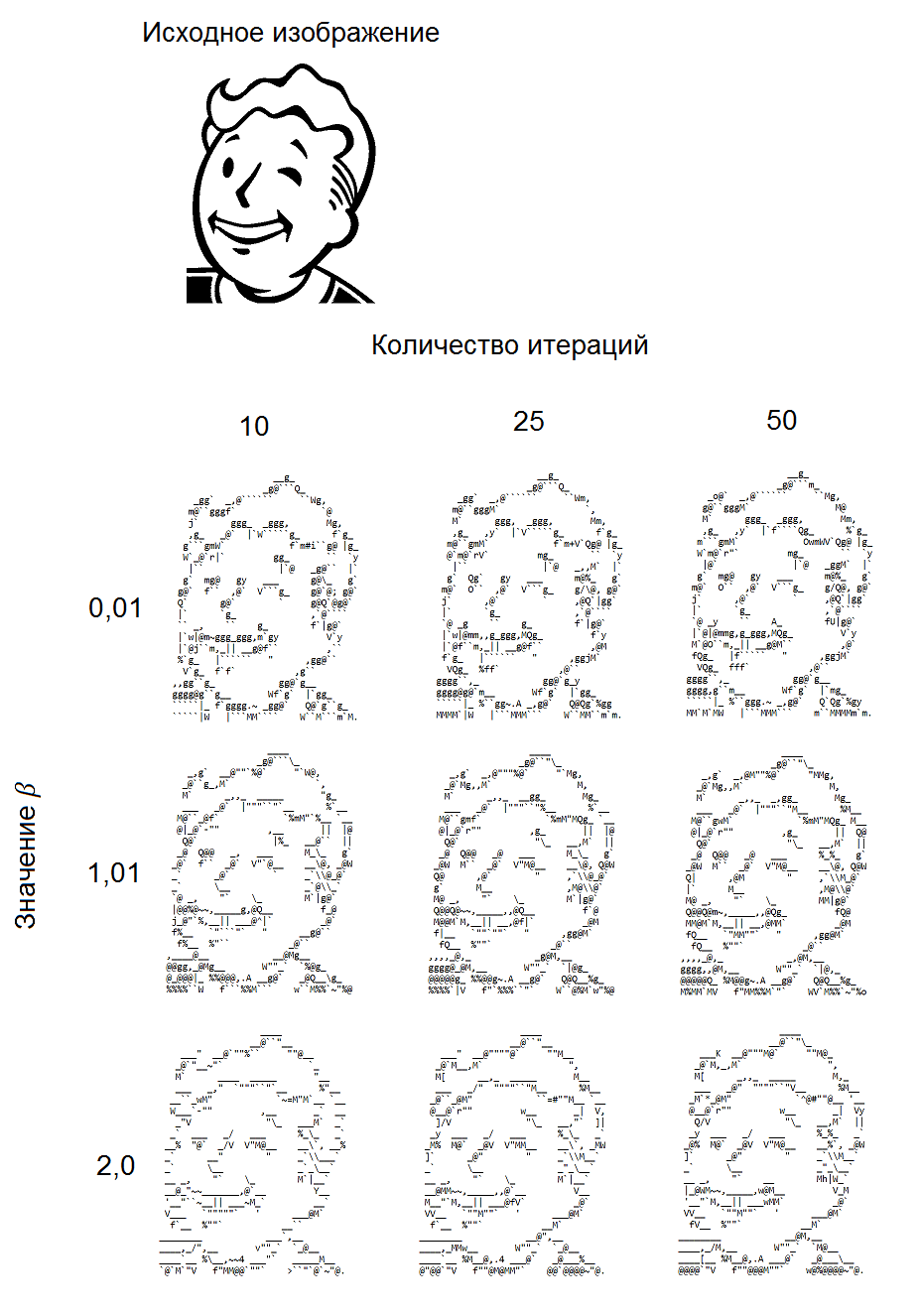Convert black and white images to ASCII graphics using non-negative matrix decomposition

In general, converting an image to ASCII graphics is a rather time-consuming task, but there are algorithms that automate this process. This article discusses the approach proposed by researchers Paul D. O'Grady and Scott T. Rickard in "Automatic ASCII Art Conversion of Binary Images Using Non-Negative Constraints . " The method described by them involves representing the image conversion process as an optimization problem and solving this problem using a non-negative matrix decomposition. Below is a description of the algorithm in question, as well as its implementation:
Algorithm description
The original image is divided into blocks of size

Each of

The normalized vectors are rewritten in the form of columns, thus forming a matrix

The resulting matrix
Matrix
It remains only to choose a matrix
This expression essentially combines several objective functions: when
Direct matrix selection
Each value

So, to determine which character should be replaced
Implementation
The algorithm is implemented in C #. ASCII graphics are generated using 95 characters (from 0x20 to 0x7E) with a size of 11x23 pixels; The font used is Courier. Below is the source code for the function to convert the original image to ASCII graphics:
public static char[,] ConvertImage( Bitmap image, double beta, double threshold, ushort iterationsCount, ushort threadsNumber, Action<int> ProgressUpdated) { int charNumHor = (int)Math.Round((double)image.Width / glyphWidth); int charNumVert = (int)Math.Round((double)image.Height / glyphHeight); int totalCharactersNumber = charNumVert * charNumHor; int glyphSetSize = wNorm.ColumnCount; Matrix<double> v = SplitImage(image, charNumVert, charNumHor); Matrix<double> h = Matrix<double>.Build.Random( glyphSetSize, totalCharactersNumber, new ContinuousUniform()); int progress = 0; ushort step = (ushort)(iterationsCount / 10); for (ushort i = 0; i < iterationsCount; i++) { UpdateH(v, wNorm, h, beta, threadsNumber); if((i + 1) % step == 0) { progress += 10; if(progress < 100) { ProgressUpdated(progress); } } } var result = GetAsciiRepresentation(h, charNumVert, charNumHor, threshold); ProgressUpdated(100); return result; }
Consider each step individually:
1) We calculate how many characters can fit in the width and height of the image:
int charNumHor = (int)Math.Round((double)image.Width / glyphWidth); int charNumVert = (int)Math.Round((double)image.Height / glyphHeight);
Using the calculated values, we divide the original image into blocks of the required size. For each block, we write the values of the pixel color intensity in the corresponding column of the matrix
private static Matrix<double> SplitImage( Bitmap image, int charNumVert, int charNumHor) { Matrix<double> result = Matrix<double>.Build.Dense( glyphHeight * glyphWidth, charNumHor * charNumVert); for (int y = 0; y < charNumVert; y++) { for (int x = 0; x < charNumHor; x++) { for (int j = 0; j < glyphHeight; j++) { for (int i = 0; i < glyphWidth; i++) { byte color = 0; if ((x * glyphWidth + i < image.Width) && (y * glyphHeight + j < image.Height)) { color = (byte)(255 - image.GetPixel( x * glyphWidth + i, y * glyphHeight + j).R); } result[glyphWidth * j + i, charNumHor * y + x] = color; } } } } result = result.NormalizeColumns(2.0); return result; }
2) Fill the matrix
Matrix<double> h = Matrix<double>.Build.Random( glyphSetSize, totalCharactersNumber, new ContinuousUniform());
We apply the update rule a specified number of times to its elements:
for (ushort i = 0; i < iterationsCount; i++) { UpdateH(v, wNorm, h, beta, threadsNumber); if((i + 1) % step == 0) { progress += 10; if(progress < 100) { ProgressUpdated(progress); } } }
Directly updating the matrix elements is implemented as follows (unfortunately, the problems associated with division by zero are solved with the help of some crutches):
private static void UpdateH( Matrix<double> v, Matrix<double> w, Matrix<double> h, double beta, ushort threadsNumber) { const double epsilon = 1e-6; Matrix<double> vApprox = w.Multiply(h); Parallel.For( 0, h.RowCount, new ParallelOptions() { MaxDegreeOfParallelism = threadsNumber }, j => { for (int k = 0; k < h.ColumnCount; k++) { double numerator = 0.0; double denominator = 0.0; for (int i = 0; i < w.RowCount; i++) { if (Math.Abs(vApprox[i, k]) > epsilon) { numerator += w[i, j] * v[i, k] / Math.Pow(vApprox[i, k], 2.0 - beta); denominator += w[i, j] * Math.Pow(vApprox[i, k], beta - 1.0); } else { numerator += w[i, j] * v[i, k]; if (beta - 1.0 > 0.0) { denominator += w[i, j] * Math.Pow(vApprox[i, k], beta - 1.0); } else { denominator += w[i, j]; } } } if (Math.Abs(denominator) > epsilon) { h[j, k] = h[j, k] * numerator / denominator; } else { h[j, k] = h[j, k] * numerator; } } }); }
3) The last step is to choose a suitable symbol for each image section by finding the maximum values in the matrix columns
private static char[,] GetAsciiRepresentation( Matrix<double> h, int charNumVert, int charNumHor, double threshold) { char[,] result = new char[charNumVert, charNumHor]; for (int j = 0; j < h.ColumnCount; j++) { double max = 0.0; int maxIndex = 0; for (int i = 0; i < h.RowCount; i++) { if (max < h[i, j]) { max = h[i, j]; maxIndex = i; } } result[j / charNumHor, j % charNumHor] = (max >= threshold) ? (char)(firstGlyphCode + maxIndex) : ' '; } return result; }
The resulting image is written to the html file. The full source code of the program can be found here .
Examples of generated images
Below are examples of images generated at various parameter values

Conclusion
In the considered algorithm, the following disadvantages can be distinguished:
- Long image processing: depending on the size of the image and the number of iterations, its processing can take from several tens of seconds to several tens of minutes.
- Poor quality processing of detailed images. For example, an attempt to convert an image of a human face yields the following result:

At the same time, reducing the number of parts by increasing the brightness and contrast of the image can significantly improve the appearance of the resulting image:

In general, despite these shortcomings, we can conclude that the algorithm gives satisfactory results.
All Articles